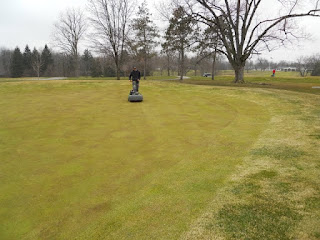Everyone likes to know what the criteria for opening are. First off, the course must be relatively dry and able to deal with cart and foot traffic. The grass has spent the winter using up its root structure as carbohydrate to survive dormancy, so there isn't great stability under the surface. We must be dry, or a couple of busy HMGC weekends could cause quite a lot of damage. Also, I like to see some growth and a vigorous, healthy plant to withstand the busy golf schedule. The last couple of years, we have had warm March temperatures that have gotten the ball rolling a little earlier than usual. Often I look at soil temperature and 'growing degree days' to guess at when the grass will be ready to accept play and offer good conditions. Based on previous years, we are about 10-days to 2 weeks behind. Here's hoping for a heat wave!
Below are a couple of pictures from the irrigation work. It was a big mess, but at least the sun was shining.
 |
| The fun part - digging a big, muddy hole to expose the 10" valve and pipe. |
 |
| Rebar and concrete hold the valve still, so we needed a torch to get things freed up. |
 |
| When in doubt, a chainsaw will cut just about anything. |
 |
| The valve probably weighs about 200 lbs, so the skid-steer loader was the best way to get it out. |


No comments:
Post a Comment